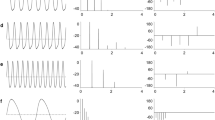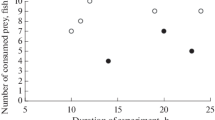Summary
The jamming avoidance response (JAR) is an increase or decrease in an electric fish's frequency of electric organ discharges (EODs), in order to avoid “jamming” of its electrolocation sense by another fish at a slightly lower or higher frequency. This study is concerned with the pulse speciesHypopomus occidentalis andGymnotus carapo, which fire their electric organs in brief pulses separated by intervals of silence.
The JAR can be obtained in curarized preparations in which a train of EOD-mimic (S 1) pulses is scanned by a train of jamming pulses (S 2) mimicking a “foreign” fish at a slightly lower frequency (“left-right scan”) or a higher frequency (“right-left scan”); see Fig. 1. Thus the behavior is a function of a single temporal waveform, providing an experimentally convenient preparation in which to study a temporal pattern discrimination problem.
Neurophysiological studies of the sensory encoding of JAR-eliciting stimuli show that burst duration coders (BDCs, Fig. 2), but not pulse markers (Fig. 3) or ampullary cells (Fig. 5), provide information related to normal scanning stimuli. BDCs fire a burst of spikes, phase-locked to the largeS 1 pulse; the burst is modulated by theS 2 scanning stimuli. These cells respond differentially to the EOD-mimic signal and the other fish's signals on the basis of amplitude.
BDC responses to left-right and right-left scans are approximate mirror images (Fig. 2). This and other observations indicate that BDC activity reflects primarily the most recentS 1+S 2 waveform.
The behavioral discrimination of left-right vs. right-left scans is invariant with respect to an inversion of the “foreign” fish's signal, yet this procedure reverses the responses of BDCs (Fig. 7). Consequently the sequence of excitation and inhibition from any one receptor is ambiguous.
BDCs can be classified into four categories, based on the range ofS 1/S 2 latencies at which they respond and by their current direction sensitivity (Fig. 8):α-cells have lowest thresholds to negative (inward) current,β-cells to positive (outward) current, and theγ andδ types to both (Fig. 10). The categories are not sharp (i.e., intermediate types exist). The types are scattered along the length of the fish (Fig. 11).
One proposal is that the central nervous system compares the relative timing of responses from the different classes of BDCs, in order to discriminate left-right vs. right-left scans. An alternative idea is that the JAR is controlled by the sequence of “gentle” vs. “strong” perturbations of overall electroreceptive feedback.
Similar content being viewed by others
Abbreviations
- BDC :
-
burst duration coder
- CNS :
-
central nervous system
- EOD :
-
electric organ discharge
- JAR :
-
jamming avoidance response
References
Baker, C.L., Heiligenberg, W., Bastian, J.: The jamming avoidance response in an electric fish pulse species: behavior and sensory neurophysiology. Neurosci. Abstr.4, 361 (1978)
Bastian, J.: Frequency response characteristics of electroreceptors in weakly electric fish (Gymnotoidei) with a pulse discharge. J. Comp. Physiol.112, 165–180 (1976)
Bastian, J.: Variations in the frequency response of electroreceptors dependent on receptor location in weakly electric fish (Gymnotoidei) with a pulse discharge. J. Comp. Physiol.121, 53–64 (1977)
Bennett, M.V.L.: Mechanisms of electroreception. In: Lateral line detectors. Cahn, P. (ed.), pp. 313–393. Bloomington, Indiana: Indiana Univ. Press 1967
Bullock, T.H.: Representation of information in neurons and sites for molecular participation. P.N.A.S.60, 1058–1068 (1968)
Bullock, T.H.: Species differences in effect of electroreceptor input on electric organ pacemakers and other aspects of behavior in electric fish. Brain, Behav. Evol.2, 85–118 (1969)
Bullock, T.H., Hagiwara, S., Kusano, K., Negishi, K.: Evidence for a category of electroreceptors in the lateral line of Gymnotoid fishes. Science134, 1426–1427 (1961)
Bullock, T.H., Hamstra, R.H., Scheich, H.: The jamming avoidance response in high frequency electric fish. I. General features. J. Comp. Physiol.77, 1–22 (1972)
Bullock, T.H., Hamstra, R.H., Scheich, H.: The Jamming Avoidance Response in high frequency electric fish. II. Quantitative aspects. J. Comp. Physiol.77, 23–48 (1972)
Gottschalk, B., Scheich, H.: Phase sensitivity and phase coupling: common mechanisms for communication behaviors in gymnotoid wave and pulse species. Behav. Ecol. Sociobiol.4, 395–408 (1979)
Hagiwara, S., Kusano, K., Negishi, K.: Physiological properties of electroreceptors of some Gymnotids. J. Neurophysiol.25, 430–449 (1962)
Hagiwara, S., Morita, H.: Coding mechanisms of electroreceptor fibers in some electric fish. J. Neurophysiol.26, 551–567 (1963)
Heiligenberg, W.: Electrolocation and jamming avoidance inHypopygus (Rhamphichthyidae, Gymnotoidei), an electric fish with pulse-type discharges. J. Comp. Physiol.91, 223–240 (1974)
Heiligenberg, W.: Principles of electrolocation and jamming avoidance in electric fish. Berlin, Heidelberg, New York: Springer 1977
Heiligenberg, W.: The evaluation of electroreceptive feedback in a gymnotoid fish with pulse-type electric organ discharges. J. Comp. Physiol. (submitted) (1980)
Heiligenberg, W., Baker, C.L., Bastian, J.: The jamming avoidance response in gymnotoid pulse-species: a mechanism to minimize the probability of pulse-train coincidence. J. Comp. Physiol.124, 211–224 (1978a)
Heiligenberg, W., Baker, C.L., Matsubara, J.: The jamming avoidance response inEigenmannia revisted: The structure of a neuronal democracy. J. Comp. Physiol.127, 267–286 (1978b)
Heiligenberg, W., Bastian, J.: The control ofEigenmannia's pacemaker by distributed evaluation of electroreceptive afferences. J. Comp. Physiol.136, 113–133 (1980)
Hopkins, C.D., Heiligenberg, W.H.: Evolutionary designs for electric signals and electroreceptors in gymnotoid fishes of Surinam. Behav. Ecol. Sociobiol.3, 113–134 (1978)
Russell, C.J., Bell, C.C.: Neuronal responses to electrosensory input in mormyrid valvula cerebelli. J. Neurophysiol.41, 1495–1510 (1978)
Scheich, H.: Neural basis of communication in the high frequency electric fish,Eigenmannia virescens (Jamming avoidance response). I. Open loop experiments and the time domain concept of signal analysis. J. Comp. Physiol.113, 181–206 (1977)
Scheich, H.: Neural basis of communication in the high frequency electric fish,Eigenmannia virescens (jamming avoidance response). II. Jammed electroreceptor neurons in the lateral line nerve. J. Comp. Physiol.113, 207–227 (1977)
Scheich, H.: Neural basis of communication in the high frequency electric fish,Eigenmannia virescens (jamming avoidance response). III. Central integration in the sensory pathway and control of the pacemaker. J. Comp. Physiol.113, 229–255 (1977)
Scheich, H., Bullock, T.H.: The detection of electric fields from electric organs. In: Handbook of sensory physiology, Vol. III/3. Fessard, A. (ed.), pp. 201–256. Berlin, Heidelberg, New York: Springer 1974
Scheich, H., Gottschalk, B., Nickel, B.: The jamming avoidance response inRhamphichthys rostratus: An alternative principle of time domain analysis in electric fish. Exp. Brain Res.28, 229–233 (1977)
Schlegel, P.A.: Perception of objects in weakly electric fishGymnotus carapo as studied in recordings from rhombencephalic neurons. Exp. Brain Res.18, 340–354 (1973)
Suga, N.: Coding in tuberous and ampullary organs of a gymnotid electric fish. J. Comp. Neurol.131, 437–452 (1967)
Szabo, T.: Sense organs of the lateral line system in some electric fish of the Gymnotidae, Mormyridae, and Gymnarchidae. J. Morphol.117, 229–250 (1965)
Szabo, T.: Anatomy of the specialized lateral line organs of electroreception. In: Handbook of sensory physiology, Vol. III/3. Fessard, A. (ed.), pp. 13–58. Berlin, Heidelberg, New York: Springer 1974
Szabo, T., Fessard, A.: Physiology of electroreceptors. In: Handbook of sensory physiology, Vol. III/3. Fessard, A. (ed.), pp. 59–124. Berlin, Heidelberg, New York: Springer 1974
Watanabe, A., Takeda, K.: The change of discharge frequency by A.C. stimulus in a weakly electric fish. J. Exp. Biol.40, 57–66 (1963)
Westby, G.W.M.: Has the latency-dependent response ofGymnotus carapo to discharge-triggered stimuli a bearing on electric fish communication? J. Comp. Physiol.96, 307–341 (1975)
Zipser, B., Bennett, M.V.L.: Interaction of electrosensory and electromotor signals in the lateral line lobe of a mormyrid fish. J. Neurophysiol.39, 713–721 (1976)
Author information
Authors and Affiliations
Additional information
I thank J. Bastian, T.H. Bullock, W. Heiligenberg, C. Hopkins, and D. Zimmerman for their useful technical suggestions as well as comments on the manuscript. I am particularly indebted to Dr. Fritz Vollrath, as well as W. Heiligenberg, who through the cooperation of the Smithsonian Institution (Balboa, Panama Canal Zone) were able to provideHypopomus occidentalis. This research was supported by NIMH grant PHSMH-2614904 and NSF grant BNS76-20761 to W. Heiligenberg.
Rights and permissions
About this article
Cite this article
Baker, C.L. Jamming avoidance behavior in Gymnotoid electric fish with pulse-type discharges: Sensory encoding for a temporal pattern discrimination. J. Comp. Physiol. 136, 165–181 (1980). https://doi.org/10.1007/BF00656910
Accepted:
Issue Date:
DOI: https://doi.org/10.1007/BF00656910




